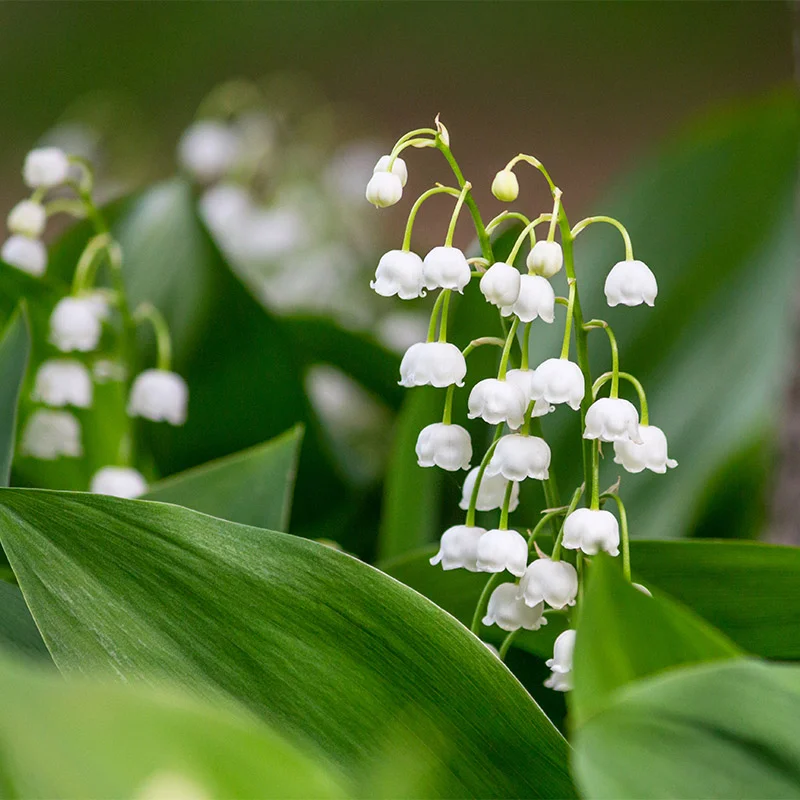Your cart is currently empty!
Lilies of the valley

Lily of the valley (lat. Convallaria majalis) is an elegant perennial plant known for its white bell-shaped flowers and pleasant aroma.
Origin of the name
Latin name Convallaria majalis translates as "May lily of the valleys", reflecting its natural habitat - shady forest valleys.
Who gave the name "lily of the valley"?
The Slavic name "lily of the valley" is considered to be derived from the Polish word "lęda", meaning "lowland" or "wasteland." This reflects the natural habitat of the lily of the valley - shady, low-lying wooded areas.
The Latin name of the plant is Convallaria majalis – was officially introduced by Carl Linnaeus in the 18th century.
- Convallaria comes from Latin "convallis" - "valley".
- Majalis means "May", indicating the flowering period of the plant.
Together, the name can be translated as "May lily of the valleys."
In English, lily of the valley is known as "Lily of the Valley" (Lily of the Valleys). This name, like the Latin name, emphasizes the place of growth of the plant and its similarity to lilies.
Lily of the valley also has a poetic connotation in English culture. In the Victorian language of flowers, it symbolized the return of happiness and tenderness.
Historical facts and symbols
Lilies of the valley are an amazing plant with a rich history and interesting features.
Lily of the valley is mentioned in the myths and folklore of many peoples. In ancient Greek mythology, it was associated with the goddess Diana, and in the Christian tradition it is considered a symbol of purity and modesty.
Lily of the valley symbolizes tenderness, love and rebirth, and is also widely associated with spring.
Myths and Legends
- Greece: Lily of the valley was considered a gift from the god Apollo. He supposedly grew it to shelter the nymphs from the scorching sun.
- Christianity: According to legend, lilies of the valley grew from the tears of the Virgin Mary when she mourned the crucifixion of Christ. That is why it is called "the tears of the Virgin Mary."
- Europe: The French associate the lily of the valley with the May Day holiday, which has become a symbol of good luck and love.
Cultural significance
- In England, lily of the valley is called "May lily"
- In Finland, the lily of the valley is the national flower
- In the Victorian era, lilies of the valley symbolized the "return of happiness"
Interesting facts
- Poisonous plant:
All parts of the lily of the valley contain toxic substances - cardiac glycosides. They can be dangerous for humans and animals if ingested. - Medical use:
In ancient times and in modern medicine, lily of the valley was used to treat heart disease, as well as a diuretic. - Perfumery:
The natural scent of lily of the valley is highly prized, but it is difficult to extract from the flowers. Therefore, a synthetic version is used in modern perfumery - Bloom:
Lily of the valley blooms in May-June, and each brush can contain from 5 to 15 flowers. It is one of the earliest spring plants - Ecological role:
Lilies of the valley prefer to grow in the wild – in shady forests and forest edges. They are resilient and can form dense carpets. - Varieties and varieties:
There are decorative varieties with double flowers, variegated leaves or unusual shades (for example, pink lilies of the valley).
Planting with roots
- Select a location: Lilies of the valley prefer shady or semi-shady areas. The ideal soil is moist, rich in organic matter and well-drained.
- Preparing the roots:
- Purchased or dug up rhizomes should be checked for freshness and damaged areas should be removed.
- If desired, you can soak the roots in warm water for 2-3 hours before planting.
- Landing:
- Plant the rhizomes at a depth of 2-3 cm, leaving the tops of the buds at ground level.
- The distance between plants is 10–15 cm.
- Landing time:
- Lily of the valley roots can be planted almost all year round.
Care
- Watering:
- Lilies of the valley love humidity, but do not tolerate stagnant water. Regular watering is especially important during the growing season.
- Top dressing:
- Apply organic fertilizer or compost in the spring.
- In mid-summer, you can add complex mineral fertilizer.
- Reproduction:
- Lilies of the valley grow quickly. To control this, replant the plants every 3-4 years.
- Divide the rhizomes in the fall or spring.
- Preparing for winter:
- Lilies of the valley are frost-resistant, but in regions with severe winters, cover the area with a layer of mulch or peat
- Pest Control:
- The main enemies are slugs and nematodes. Use organic products or special preparations.
- Lilies of the valley do not tolerate heat: Lily of the valley can live for decades, provided it is kept in a cool environment. It can withstand temperatures as low as -11°C. If you are growing the plant in a hotter climate or during the summer, it is important to give this plant shade. Shade is vital in the afternoon when temperatures are at their peak.

Leave a Reply